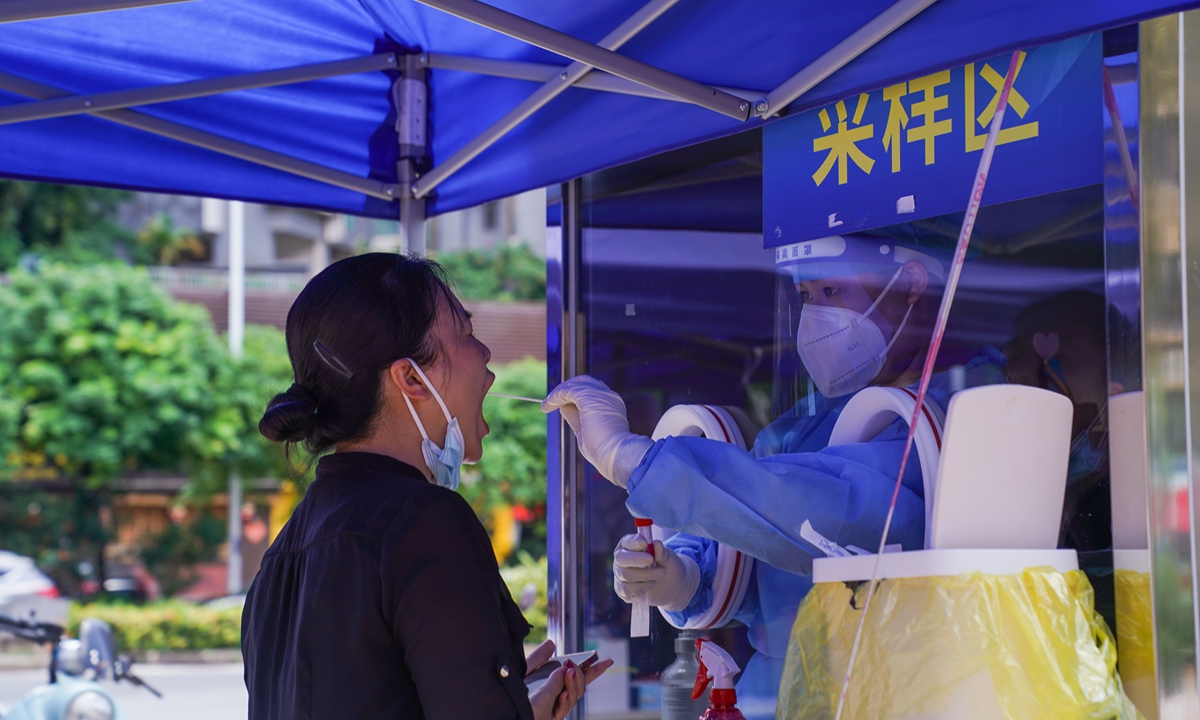20 provincial-level regions report COVID-19 cases with multiple surpassing 400 on daily basis
Emerging subvariants test coping ability of inland, small cities

Residents take nucleic acid tests in Nanning, Southwest China's Guangxi Zhuang Autonomous Region on July 16, 2022. Photo: IC
More than 20 provincial-level regions in the Chinese mainland have reported locally transmitted COVID-19 cases, and daily caseloads have begun to tick up in recent days. Epidemiologists said this new wave is challenging the coping ability of more inland and small cities, which are not as well equipped as metropolises, and emerging subvariants of Omicron further press anti-virus efforts as they spread faster and are harder to detect.
The Chinese mainland has registered over 400 domestically transmitted COVID-19 cases every day for five consecutive days. Previously, from July 2 to 11, over 300 cases were reported every day. Some 199 confirmed cases and 539 silent carriers were reported on Tuesday.
Provincial-level regions such as Anhui, Guangxi and Gansu became the latest hotspots. Anhui's Sixian, which witnessed a spike of cases in early July, resumed normal life and production last week, but other small cities in Anhui, such as Bengbu's Huaiyuan county, are still struggling with the flare-ups.
A popular tourist spot, Guangxi's Beihai, urged on Monday local residents not to leave the city unless necessary, after seeing a surge of case numbers. Gansu is also in hot water coping with the outbreak.
Beihai reported 134 confirmed cases and 104 silent carriers for Monday. In Gansu, the confirmed case number was 32, with another 199 asymptomatic patients.
Compared with previous outbreaks since March, the latest outbreak exposed a new trend, that is the infection has sneaked into inland and small cities, said an expert from the Chinese Center for Disease Control and Prevention (CDC), who requested anonymity.
He said that compared with cities such as Shanghai, Beijing and Jilin, which faced the severest onslaughts during the last round of outbreak, those that are seeing a surge this time are less equipped medically, and in a poorer condition to cope with the virus.
Apart from large-scale outbreaks in small cities, big cities such as Shanghai and Tianjin still saw tiny flare-ups in recent days. From Tuesday to Thursday, Shanghai will conduct mass testing in areas such as Huangpu, Xuhui, Jingan and others where positive cases emerged.
On Monday, one crew member of an Air China international inbound flight and his wife tested positive for COVID-19 in Beijing, cutting the record of the capital city reporting zero new cases in the past seven days.
The CDC expert said that more subvariants have emerged during the new round of outbreaks, such as BA.2, BA.4 and BA.5, and the fact that they are more transmissible and harder to find poses challenges for the country's COVID-19 control efforts.
A new subvariant of Omicron BA.2.12.1 was found in Chengdu, capital of Southwest China's Sichuan Province, said Chengdu's health authorities on Sunday, noting it is 1.2 times as transmissible as BA.2, and no homologous sequence was found in the Chinese mainland.
The new variants were discovered in the mainland in recent months. Since July 6, the first local case of the BA.5 variant in the city of Xi'an, Shaanxi Province, China has reported 10 subvariants of Omicron, media reports said.
In an interview with China News Service, Dong Xiaoping, the chief expert of virology at the CDC, said compared with previous subvariants, BA.4 and BA.5 are more transmissible, but they result in roughly the same symptoms as others.
Dong said that those new variants' ability to evade the immune system is enhanced, but the current vaccines are still preventing deaths and severe conditions.
Experts noted that China's current anti-virus measures are effective in fending off those new subvariants, as the updated handbook of handling COVID-19 has focused on detection of mass public, which helps to find virus carriers quickly and stop the infection from spilling over.

